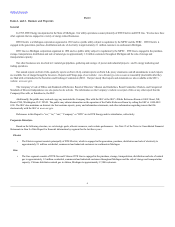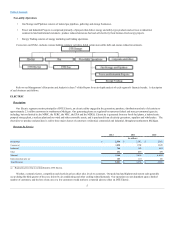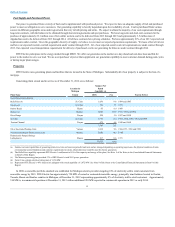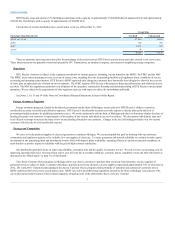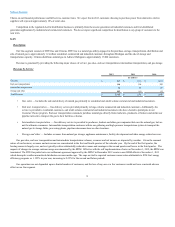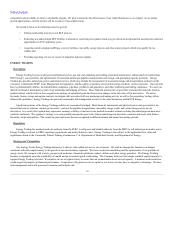DTE Energy 2012 Annual Report Download - page 16
Download and view the complete annual report
Please find page 16 of the 2012 DTE Energy annual report below. You can navigate through the pages in the report by either clicking on the pages listed below, or by using the keyword search tool below to find specific information within the annual report.
Table of Contents
competitors and our ability to achieve sustainable margins. We plan to maximize the effectiveness of our related businesses as we expand. As we pursue
growth opportunities, our first priority will be to achieve value-added returns.
We intend to focus on the following areas for growth:
•Selling membership interests in our REF projects;
•Relocating our underutilized REF facilities to alternative coal-fired power plants which may provide increased production and emission reduction
opportunities in 2013 and future years;
•Acquiring and developing landfill gas recovery facilities, renewable energy projects, and other energy projects which may qualify for tax
credits; and
•Providing operating services to owners of industrial and power plants.
Description
Energy Trading focuses on physical and financial power, gas and coal marketing and trading, structured transactions, enhancement of returns from
DTE Energy’s asset portfolio, and optimization of contracted natural gas pipeline transportation and storage, and generating capacity positions. Energy
Trading also provides natural gas, power and related services which may include the management of associated storage and transportation contracts on the
customers’ behalf under FERC Asset Management Arrangements, and the supply or purchase of renewable energy credits to various customers. Our customer
base is predominantly utilities, local distribution companies, pipelines, producers and generators, and other marketing and trading companies. We enter into
derivative financial instruments as part of our marketing and hedging activities. These financial instruments are generally accounted for under the mark-to-
market method, which results in the recognition in earnings of unrealized gains and losses from changes in the fair value of the derivatives. We utilize
forwards, futures, swaps and option contracts to mitigate risk associated with our marketing and trading activity as well as for proprietary trading within
defined risk guidelines. Energy Trading also provides commodity risk management services to the other businesses within DTE Energy.
Significant portions of the Energy Trading portfolio are economically hedged. Most financial instruments and physical power and gas contracts are
deemed derivatives; whereas, natural gas inventory, contracts for pipeline transportation, renewable energy credits and certain storage assets are not
derivatives. As a result, this segment may experience earnings volatility as derivatives are marked-to-market without revaluing the underlying non-derivative
contracts and assets. The segment’s strategy is to economically manage the price risk of these underlying non-derivative contracts and assets with futures,
forwards, swaps and options. This results in gains and losses that are recognized in different interim and annual accounting periods.
Regulation
Energy Trading has market-based rate authority from the FERC to sell power and blanket authority from the FERC to sell natural gas at market prices.
Energy Trading is subject to FERC reporting requirements and market behavior rules. Energy Trading is also subject to the applicable laws, rules and
regulations related to the Commodity Futures Trading Commission, U.S. Department of Homeland Security and Department of Energy.
Strategy and Competition
Our strategy for the Energy Trading business is to deliver value-added services to our customers. We seek to manage this business in a manner
consistent with and complementary to the growth of our other business segments. We focus on physical marketing and the optimization of our portfolio of
energy assets. We compete with electric, gas and coal marketers, financial institutions, traders, utilities and other energy providers. The Energy Trading
business is dependent upon the availability of capital and an investment grade credit rating. The Company believes it has ample available capital capacity to
support Energy Trading activities. We monitor our use of capital closely to ensure that our commitments do not exceed capacity. A material credit restriction
would negatively impact our financial performance. Competitors with greater access to capital or at a lower cost may have a competitive advantage. We have
risk management and credit processes to monitor and mitigate risk.
14


